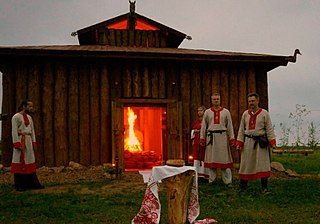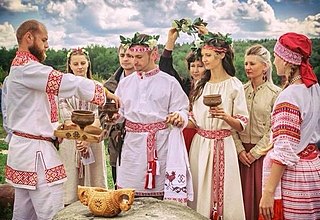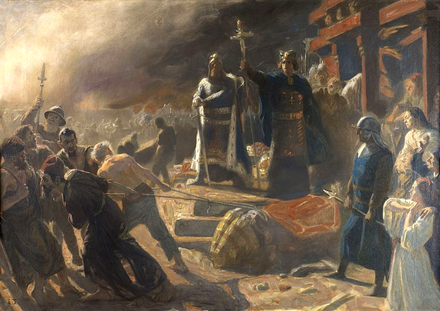Prav (Правь), Yav (Явь) and Nav (Навь) are the three dimensions or qualities of the cosmos as described in the first chapter of the Book of Light and in the Book of Veles of Slavic Native Faith (Rodnovery). Older sources mention only Nav and Yav concepts of ancient slavic cosmology, similar to Yin and Yang in Taoism, and Prav was not part of the concept. The literal meanings of the Prav, Yav, and Nav words, are, respectively, "Right", "actuality" and "probability". They are also symbolised as a unity by the god Triglav. Already Ebbo documented that the Triglav was seen as embodying the connection and mediation between Heaven, Earth and the underworld / humanity; these three dimensions were also respectively associated to the colours white, green and black as documented by Karel Jaromír Erben.

The Slavic Native Faith, commonly known as Rodnovery and sometimes as Slavic Neopaganism, is a modern Pagan religion. Classified as a new religious movement, its practitioners hearken back to the historical belief systems of the Slavic peoples of Central and Eastern Europe, though the movement is inclusive of external influences and hosts a variety of currents. "Rodnovery" is a widely accepted self-descriptor within the community, although there are Rodnover organisations which further characterise the religion as Vedism, Orthodoxy, and Old Belief.

A volkhv or volhv is a priest in ancient Slavic religions and contemporary Slavic Native Faith.

Ynglism, institutionally the Ancient Russian Ynglist Church of the Orthodox Old Believers–Ynglings, is a white nationalist branch of Slavic paganism formally established in 1992 by Aleksandr Yuryevich Khinevich in Omsk, Russia, and legally recognised by the Russian state in 1998, although the movement was already in existence in unorganised forms since the 1980s. The adherents of Ynglism call themselves "Orthodox", "Old Believers", "Ynglings" or "Ynglists".
Ivanovism is a Rodnover new religious movement and healing system in Eastern Europe based on the teachings of the Russian mystic Porfiry Korneyevich Ivanov (1898–1983), who elaborated his doctrines by drawing upon Russian folklore. The movement began to take institutional forms between the 1980s and the 1990s, and in the same period it had an influence on the other Rodnover movement of Peterburgian Vedism.

Peterburgian Vedism or Peterburgian Rodnovery, or more broadly Russian Vedism and Slavic Vedism, is one of the earliest branches of Rodnovery and one of the most important schools of thought within it, founded by Viktor Nikolayevich Bezverkhy in Saint Petersburg, Russia, in the 1970s. Early Peterburgian Vedism developed independently from other Rodnover movements in the inland of Russia, due to the distinguished culture of the city of Saint Petersburg itself, and represents one of the most cohesive right-wing nationalist Rodnover movements.

The Native Ukrainian National Faith, also called Sylenkoism (Силенкоїзм) or Sylenkianism (Силенкіянство), and institutionally also known as the Church of Ukrainian Native Faith or Church of the Faithful of the Native Ukrainian National Faith, is a branch of Rodnovery specifically linked to the Ukrainians that was founded in the mid 1960s by Lev Sylenko (1921–2008) among the Ukrainian diaspora in North America, and first introduced in Ukraine in 1991. Sylenkoite communities are also present in Russia and Belarus, as well as in Western Europe and Oceania. The doctrine of this tradition is codified into a sacred book composed by Sylenko himself, the Maha Vira. Sylenkoite theology is characterised by a solar monotheism.
In Slavic Native Faith (Rodnovery) there are a number of shared holidays throughout the year, when important ritual activities are set according to shared calendars. Generally speaking, ritual activities may be distinguished into "external" (exoteric) and "internal" (esoteric) relatively to the different communities. External ceremonies are mass gatherings, usually held on important holidays dedicated to the worship of common gods, and involving large numbers of people. Internal ceremonies are those restricted to specific groups, and holding special meaning for such groups; they may comprise private rituals and worship of specific ancestors.

Slavic Native Faith or Slavic Neopaganism in Russia is widespread, according to some estimates from research organisations which put the number of Russian Rodnovers in the millions. The Rodnover population generally has a high education and many of its exponents are intellectuals, many of whom are politically engaged both in the right and the left wings of the political spectrum. Particular movements that have arisen within Russian Rodnovery include various doctrinal frameworks such as Anastasianism, Authentism, Bazhovism, Ivanovism, Kandybaism, Levashovism, Peterburgian Vedism, Slavic-Hill Rodnovery, Vseyasvetnaya Gramota, the Way of Great Perfection, the Way of Troyan, and Ynglism, as well as various attempts to construct specific ethnic Rodnoveries, such as Krivich Rodnovery, Meryan Rodnovery, Viatich Rodnovery. Rodnovery in Russia is also influenced by, and in turn influences, movements that have their roots in Russian cosmism and identify themselves as belonging to the same Vedic culture, such as Roerichism and Blagovery.
The Slavic Native Faith in Ukraine has an unspecified number of adherents which ranges between the thousands and the tens of thousands.
Slavic Native Faith (Rodnovery) has a theology that is generally monistic, consisting in the vision of a transcendental, supreme God which begets the universe and lives immanentised as the universe itself, present in decentralised and autonomous way in all its phenomena, generated by a multiplicity of deities which are independent hypostases, facets, particles or energies of the consciousness and will of the supreme God itself.

In the Russian intellectual milieu, Slavic Native Faith (Rodnovery) presents itself as a carrier of the political philosophy of nativism/nationalism/populism (narodnichestvo), intrinsically related to the identity of the Slavs and the broader group of populations with Indo-European speaking origins, and intertwined with historiosophical ideas about the past and the future of these populations and their role in eschatology.
Slavic Native Faith in Poland has in 2007, according to Scott Simpson, between 2000 and 2500 "actively engaged and regular participants". In 2020, Konrad Kośnik and Elżbieta Hornowska estimated that Rodnovers in Poland were between 7000 and 10,000.

Blagovery or Russian Zoroastrianism is a branch of Zoroastrianism practised in Russia. It emerged in the 1990s under the influence of Pavel P. Globa, in Saint Petersburg, as an independent movement from usually endogamous Iranian Zoroastrians. In the 2000s, it was joined by another community in Moscow, initiated by the Iranian priest Kamran Jamshidi. The movement has close ties with Rodnovery.
Slavic-Hill Rodnovery is one of the earliest branches of Rodnovery that emerged in Russia in the 1980s founded by Aleksandr Konstantinovich Belov (1957–), and one of the largest Rodnover movements in terms of number of practitioners, counted in the many tens of thousands. The movement is characterised by a military orientation, combining Rodnover worldview with the practice of a martial arts style known as "Slavic-hill wrestling". The locution "Slavic hill" refers to the kurgan, Indo-European warrior mound burials of the Pontic–Caspian steppe.

Vseyasvetnaya Gramota is a Rodnover movement based on an elaborate doctrine of esoteric linguistics or natural philosophical linguistics, holding that there is a continuity between language, script, the cosmos and God, corroborated by the etymological relation that in East Slavic languages exists between yazychnik, "pagan", and yazyk, "language". The movement was begun in Russia by Anany Shubin-Abramov (1938–2019) in the 1980s, and was later incorporated as a homonymous public organisation.
Modern paganism, also known as contemporary paganism and neopaganism, is a collective term for new religious movements which are influenced by or derived from the various historical pagan beliefs of pre-modern peoples. Although they share similarities, contemporary pagan religious movements are diverse, and as a result, they do not share a single set of beliefs, practices, or texts.

Mono-ideologies are a type of ideology in Russian political and philosophical discourse.















